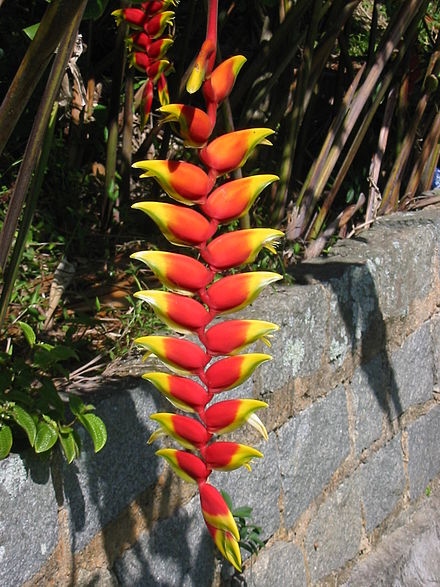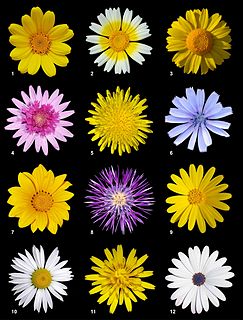
The bald eagle is a bird of prey found in North America. A sea eagle, it has two known subspecies and forms a species pair with the white-tailed eagle. Its range includes most of Canada and Alaska, all of the contiguous United States, and northern Mexico. It is found near large bodies of open water with an abundant food supply and old-growth trees for nesting.
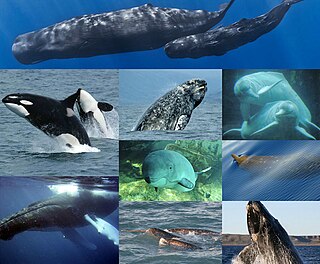
Cetaceans are aquatic mammals constituting the infraorder Cetacea. There are around 89 living species, which are divided into two parvorders. The first is the Odontoceti, the toothed whales, which consist of around 70 species, including the dolphin, porpoise, beluga whale, narwhal, sperm whale, and beaked whale. The second is the Mysticeti, the baleen whales, which have a filter-feeder system, and consist of 15 species divided into 3 families, and include the right whale, bowhead whale, rorqual, pygmy right whale, and gray whale.

Squid are cephalopods in the superorder Decapodiformes with elongated bodies, large eyes, eight arms and two tentacles. Like all other cephalopods, squid have a distinct head, bilateral symmetry, and a mantle. They are mainly soft-bodied, like octopuses, but have a small internal skeleton in the form of a rod-like gladius or pen, made of chitin.
The beak, bill, and/or rostrum is an external anatomical structure of birds that is used for eating and for preening, manipulating objects, killing prey, fighting, probing for food, courtship and feeding young. The terms beak and rostrum are also used to refer to a similar mouth part in some ornithischians, pterosaurs, turtles, cetaceans, dicynodonts, anuran tadpoles, monotremes, sirens, pufferfish, billfishes and cephalopods.

Four-toothed whales or giant beaked whales are beaked whales in the genus Berardius ("tsuchi"). They include Arnoux's beaked whale in cold Southern Hemisphere waters, and Baird's beaked whale in the cold temperate waters of the North Pacific. A third species, Berardius minimus, was distinguished from B. bairdii in the 2010s.
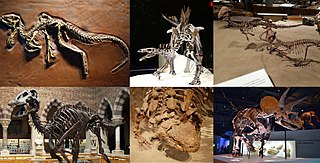
Ornithischia is an extinct clade of mainly herbivorous dinosaurs characterized by a pelvic structure similar to that of birds. The name Ornithischia, or "bird-hipped", reflects this similarity and is derived from the Greek stem ornith- (ὀρνιθ-), meaning "of a bird", and ischion (ἴσχιον), plural ischia, meaning "hip joint". However, birds are only distantly related to this group as birds are theropod dinosaurs.
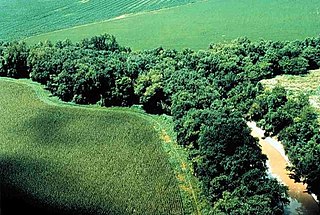
A riparian zone or riparian area is the interface between land and a river or stream. Riparian is also the proper nomenclature for one of the terrestrial biomes of the Earth. Plant habitats and communities along the river margins and banks are called riparian vegetation, characterized by hydrophilic plants. Riparian zones are important in ecology, environmental resource management, and civil engineering because of their role in soil conservation, their habitat biodiversity, and the influence they have on fauna and aquatic ecosystems, including grasslands, woodlands, wetlands, or even non-vegetative areas. In some regions the terms riparian woodland, riparian forest, riparian buffer zone,riparian corridor and riparian strip are used to characterize a riparian zone. The word riparian is derived from Latin ripa, meaning river bank.
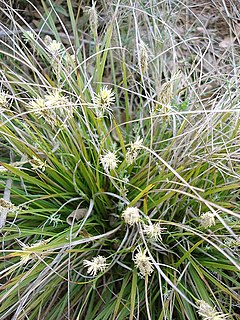
Carex is a vast genus of more than 2,000 species of grass-like plants in the family Cyperaceae, commonly known as sedges. Other members of the family Cyperaceae are also called sedges, however those of genus Carex may be called true sedges, and it is the most species-rich genus in the family. The study of Carex is known as caricology.

A rostral column is a type of victory column, originating in ancient Greece and Rome where they were erected to commemorate a naval military victory. Traditionally, rostra – the prows or rams of captured ships – were mounted on the columns. Rostral columns of the modern world include the Columbus Memorial at Columbus Circle in New York City, and the paired Saint Petersburg Rostral Columns.

Coral reef fish are fish which live amongst or in close relation to coral reefs. Coral reefs form complex ecosystems with tremendous biodiversity. Among the myriad inhabitants, the fish stand out as colourful and interesting to watch. Hundreds of species can exist in a small area of a healthy reef, many of them hidden or well camouflaged. Reef fish have developed many ingenious specialisations adapted to survival on the reefs.

The term shrimp is used to refer to some decapod crustaceans, although the exact animals covered can vary. Used broadly, shrimp may cover any of the groups with elongated bodies and a primarily swimming mode of locomotion – most commonly Caridea and Dendrobranchiata. In some fields, however, the term is used more narrowly and may be restricted to Caridea, to smaller species of either group or to only the marine species. Under the broader definition, shrimp may be synonymous with prawn, covering stalk-eyed swimming crustaceans with long narrow muscular tails (abdomens), long whiskers (antennae), and slender legs. Any small crustacean which resembles a shrimp tends to be called one. They swim forward by paddling with swimmerets on the underside of their abdomens, although their escape response is typically repeated flicks with the tail driving them backwards very quickly. Crabs and lobsters have strong walking legs, whereas shrimp have thin, fragile legs which they use primarily for perching.

The marine wildlife of Baa Atoll consists of marine species living in a circular archipelago in the Maldives, inside the administrative division of Baa Atoll, which is the southern part of Maalhosmadulu Atoll. Baa Atoll was named a biosphere reserve by UNESCO in 2011.




